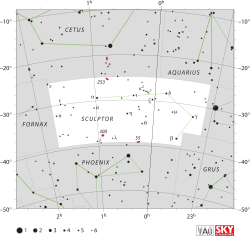Pi Sculptoris
| Pi Sculptoris (π) | |
 | |
| Observationsdata Epok: J2000.0 | |
|---|---|
| Stjärnbild | Bildhuggaren |
| Rektascension | 01t 42m 08,59623s[1] |
| Deklination | -32° 29′ 37,1331″[1] |
| Skenbar magnitud () | +5,25[2] |
| Stjärntyp | |
| Spektraltyp | K1 II/III[3] |
| U–B | +0,79[4] |
| B–V | +1,05[4] |
| Astrometri | |
| Radialhastighet () | +10,40[5] km/s |
| Egenrörelse (µ) | RA: -71,07[1] mas/år Dek.: -51,06[1] mas/år |
| Parallax () | 15,18 ± 0,70[1] |
| Avstånd | 215 ± 10 lå (66 ± 3 pc) |
| Absolut magnitud () | +1,16[2] |
| Detaljer | |
| Massa | 1,52[6] M☉ |
| Radie | 9,3[7] R☉ |
| Luminositet | 43,42[2] L☉ |
| Temperatur | 4 707[6] K |
| Metallicitet | -0,22[6] dex |
| Vinkelhastighet | <1,6[8] km/s |
| Andra beteckningar | |
| CD-32° 666, FK5 1048, GC 2085, GSC 07003-02207, HIP 7955, HR 497, HD 10537, SAO 193263 | |
Pi Sculptoris (π Sculptoris, förkortat Pi Scl, π Scl) som är stjärnans Bayerbeteckning, är en ensam stjärna belägen i den östra delen av stjärnbilden Bildhuggaren. Den har en skenbar magnitud på 5,25[2] och är svagt synlig för blotta ögat där ljusföroreningar ej förekommer. Baserat på parallaxmätning inom Hipparcosuppdraget på ca 15,2[1] mas, beräknas den befinna sig på ett avstånd på ca 215 ljusår (ca 66 parsek) från solen.
Egenskaper
[redigera | redigera wikitext]Pi Sculptoris är en orange till röd ljusstark jättestjärna av spektralklass K1 II/III[3]. Den har en massa som är drygt 50[6] procent större än solens massa, en radie som är ca 9[7] gånger större än solens och utsänder från dess fotosfär ca 43[2] gånger mera energi än solen vid en effektiv temperatur på ca 4 700[6] K.
Källor
[redigera | redigera wikitext]- Den här artikeln är helt eller delvis baserad på material från engelskspråkiga Wikipedia, tidigare version.
Referenser
[redigera | redigera wikitext]- ^ [a b c d e f] Van Leeuwen, F. (2007). "Validation of the new Hipparcos reduction". Astronomy and Astrophysics. 474 (2): 653. arXiv:0708.1752 . Bibcode:2007A&A...474..653V. doi:10.1051/0004-6361:20078357. Vizier catalog entry
- ^ [a b c d e] Anderson, E.; Francis, Ch. (2012). "XHIP: An extended hipparcos compilation". Astronomy Letters. 38 (5): 331. arXiv:1108.4971 . Bibcode:2012AstL...38..331A. doi:10.1134/S1063773712050015. Vizier catalog entry
- ^ [a b] Houk, N. (1982). "Michigan Catalogue of Two-dimensional Spectral Types for the HD stars. Volume_3. Declinations -40_ƒ0 to -26_ƒ0". Michigan Catalogue of Two-dimensional Spectral Types for the HD stars. Volume_3. Declinations -40_ƒ0 to -26_ƒ0. Bibcode:1982MSS...C03....0H.
- ^ [a b] Mermilliod, J. C. (2006). "VizieR Online Data Catalog: Homogeneous Means in the UBV System (Mermilliod 1991)". VizieR On-line Data Catalog: II/168. Originally published in: Institut d'Astronomie. 2168. Bibcode:2006yCat.2168....0M.Vizier catalog entry
- ^ Gontcharov, G. A. (2006). "Pulkovo Compilation of Radial Velocities for 35 495 Hipparcos stars in a common system". Astronomy Letters. 32 (11): 759. arXiv:1606.08053 . Bibcode:2006AstL...32..759G. doi:10.1134/S1063773706110065.
- ^ [a b c d e] Liu, Y. J.; Zhao, G.; Shi, J. R.; Pietrzynski, G.; Gieren, W. (2007). "The abundances of nearby red clump giants". Monthly Notices of the Royal Astronomical Society. 382 (2): 553. Bibcode:2007MNRAS.382..553L. doi:10.1111/j.1365-2966.2007.11852.x.
- ^ [a b] Allende Prieto, C.; Lambert, D. L. (1999). "Fundamental parameters of nearby stars from the comparison with evolutionary calculations: Masses, radii and effective temperatures". Astronomy and Astrophysics. 352: 555. arXiv:astro-ph/9911002 . Bibcode:1999A&A...352..555A. Vizier catalog entry
- ^ ^ De Medeiros, J. R.; Alves, S.; Udry, S.; Andersen, J.; Nordström, B.; Mayor, M. (2014). "A catalog of rotational and radial velocities for evolved stars". Astronomy & Astrophysics. 561: A126. arXiv:1312.3474 . Bibcode:2014A&A...561A.126D. doi:10.1051/0004-6361/201220762. Vizier catalog entry
Externa länkar
[redigera | redigera wikitext]
| ||||||||||||||||




